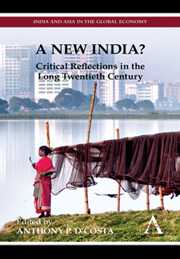Book contents
- Frontmatter
- Contents
- List of Tables and Figures
- Foreword by Deepak Nayyar
- Preface and Acknowledgements
- Chapter 1 What is this ‘New’ India? An Introduction
- Chapter 2 New Interpretations of India's Economic Growth in the Twentieth Century
- Chapter 3 Continuity and Change: Notes on Agriculture in ‘New India’
- Chapter 4 An Uneasy Coexistence: The New and the Old in Indian Industry and Services
- Chapter 5 Is the New India Bypassing Women? Gendered Implications of India's Growth
- Chapter 6 The ‘New’ Non-Residents of India: A Short History of the NRI
- Chapter 7 Revivalism, Modernism and Internationalism: Finding the Old in the New India
- Chapter 8 Creative Tensions: Contemporary Fine Art in the ‘New’ India
- List of Contributors
- Index
Chapter 3 - Continuity and Change: Notes on Agriculture in ‘New India’
Published online by Cambridge University Press: 05 March 2012
- Frontmatter
- Contents
- List of Tables and Figures
- Foreword by Deepak Nayyar
- Preface and Acknowledgements
- Chapter 1 What is this ‘New’ India? An Introduction
- Chapter 2 New Interpretations of India's Economic Growth in the Twentieth Century
- Chapter 3 Continuity and Change: Notes on Agriculture in ‘New India’
- Chapter 4 An Uneasy Coexistence: The New and the Old in Indian Industry and Services
- Chapter 5 Is the New India Bypassing Women? Gendered Implications of India's Growth
- Chapter 6 The ‘New’ Non-Residents of India: A Short History of the NRI
- Chapter 7 Revivalism, Modernism and Internationalism: Finding the Old in the New India
- Chapter 8 Creative Tensions: Contemporary Fine Art in the ‘New’ India
- List of Contributors
- Index
Summary
Over 60 years of its existence as a free nation, the Indian republic has an unflattering record in its progress as a modern, progressive and democratic nation. The standards of living of people remain extremely backward. A large section of the rural population is landless and asset-poor. Illiteracy, lack of schooling, poor conditions of health and sanitation and malnourishment continue to be important problems in rural India. Nearly half of the members of agricultural labour households are below the official income-poverty line. Informal credit is the dominant source of credit in rural India. There is no credible social security system to help the rural poor tide over crises of livelihood.
The roots of India's abysmal record in removing poverty and deprivation lie in the historic failure of the state to resolve the agrarian question. By agrarian question, I refer to the task of ending the extreme concentration of land ownership, weakening the factors that foster disincentives in investment and technology adoption, and overhauling the structure that ties workers to a social system with many pre-modern features that compress purchasing power. The nature of the agrarian question has largely shaped the pattern of India's post-independence agricultural growth. It was in this context that a set of Washington Consensus-type reforms1 began to be implemented in India in 1991. In India's backward agrarian economy, these reforms have had acute adverse effects on people's livelihoods. In the process, they have introduced new dimensions to the contradictions of the post-independence regime.
- Type
- Chapter
- Information
- A New India?Critical Reflections in the Long Twentieth Century, pp. 43 - 70Publisher: Anthem PressPrint publication year: 2010
- 2
- Cited by



